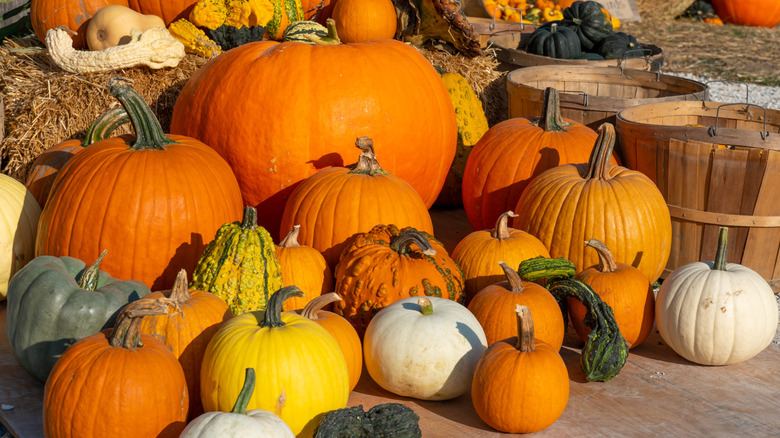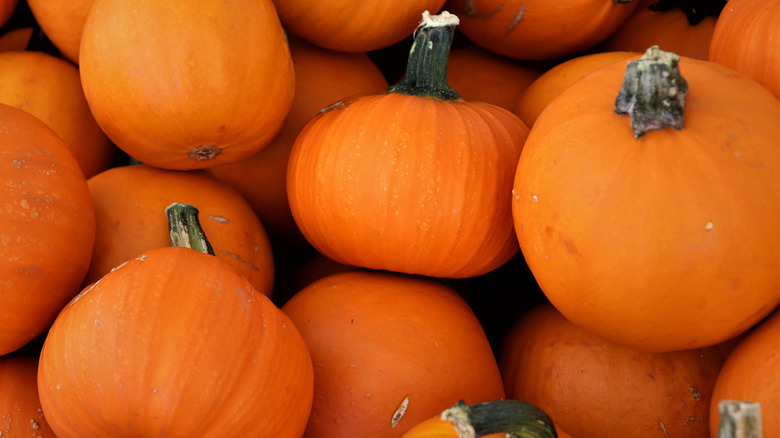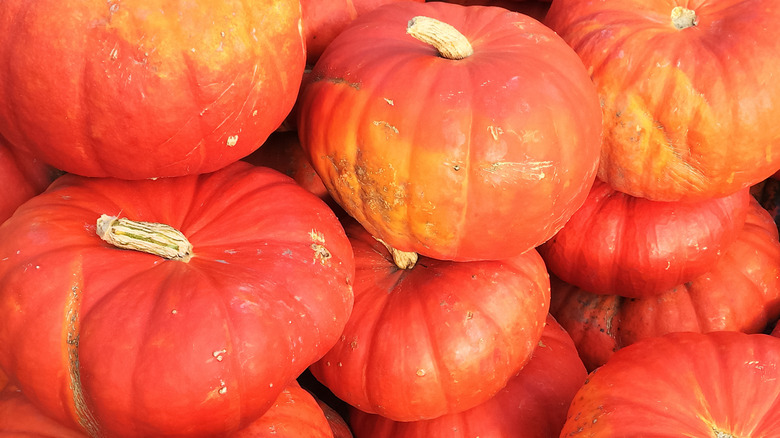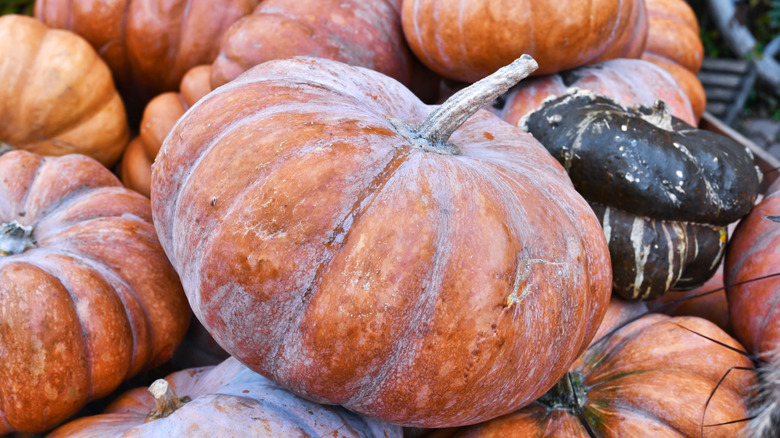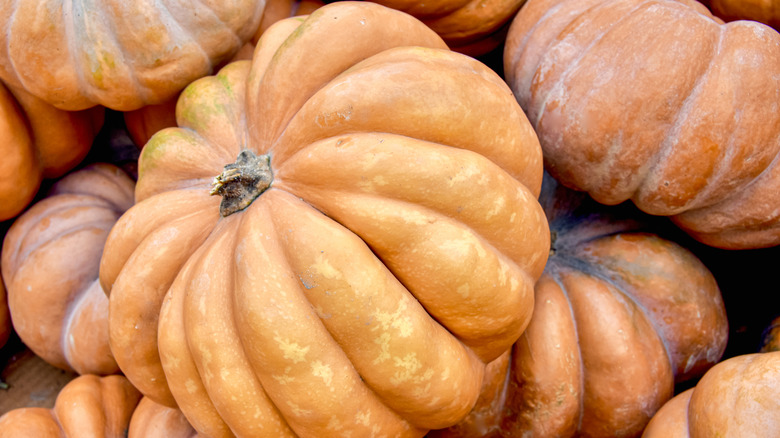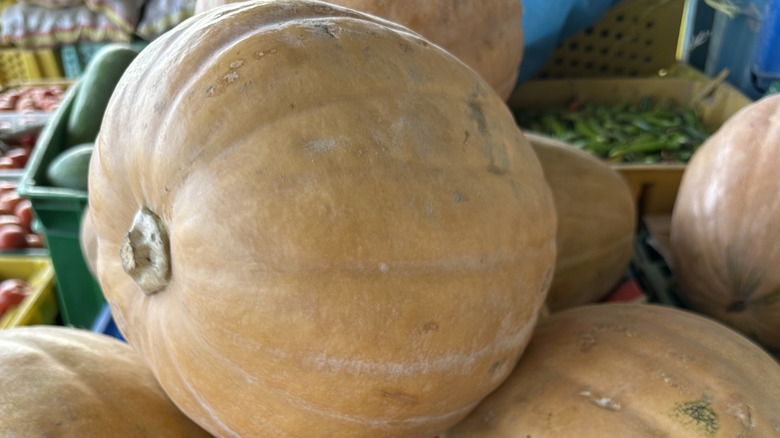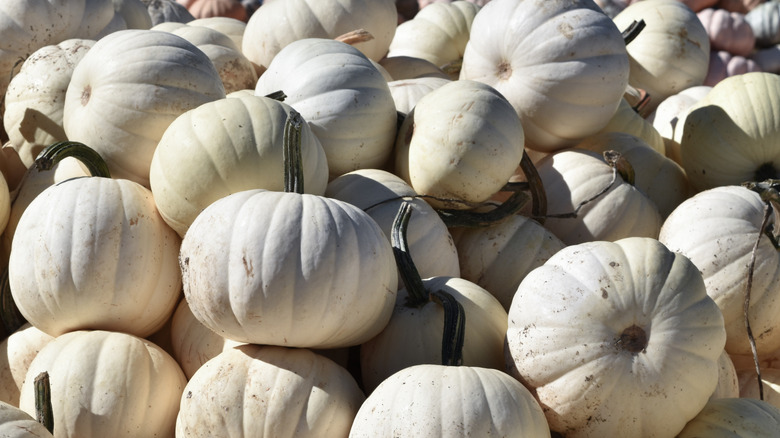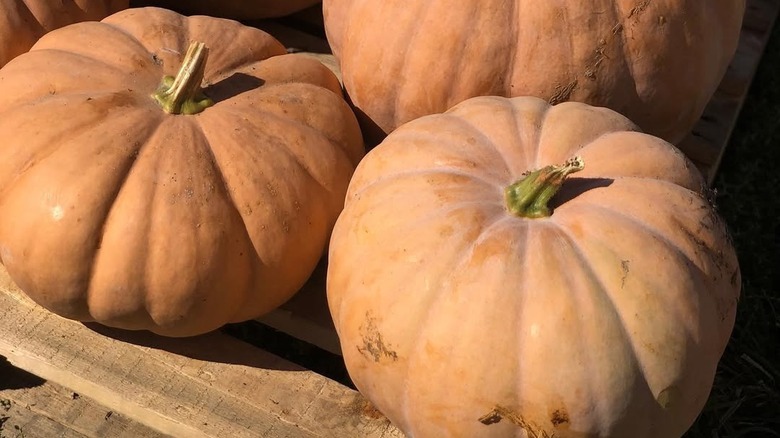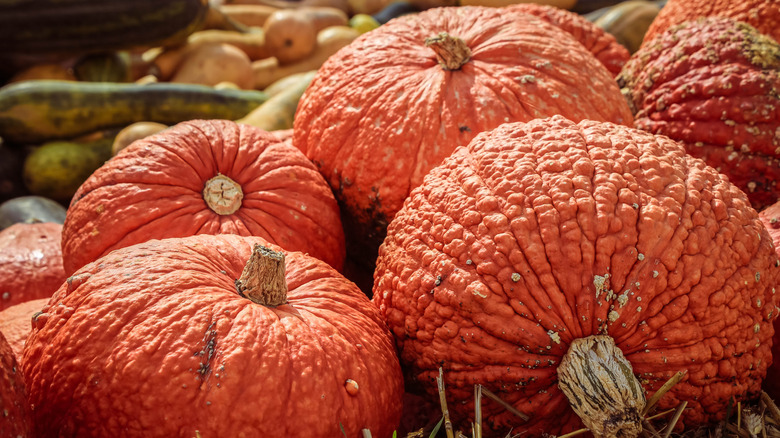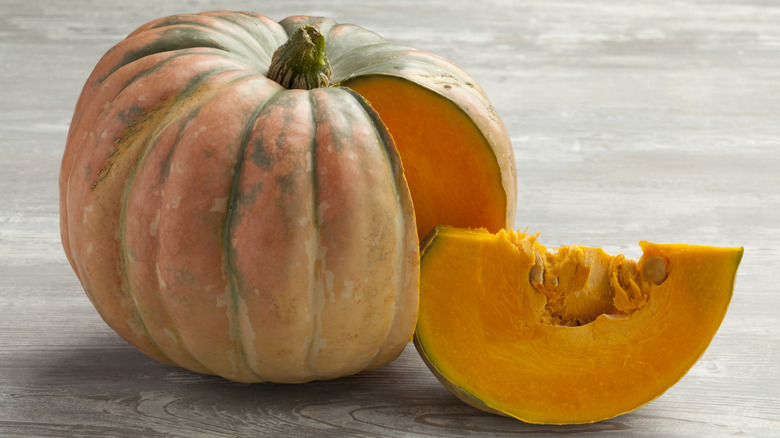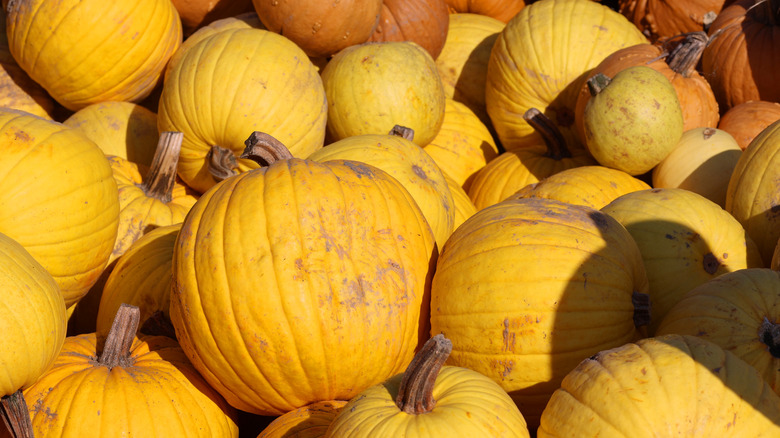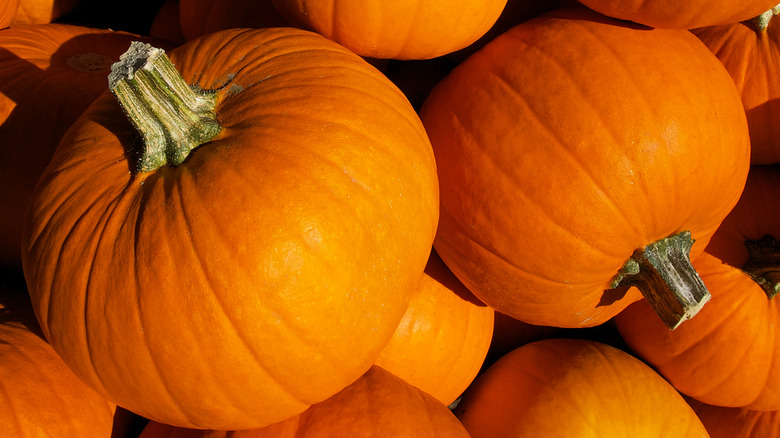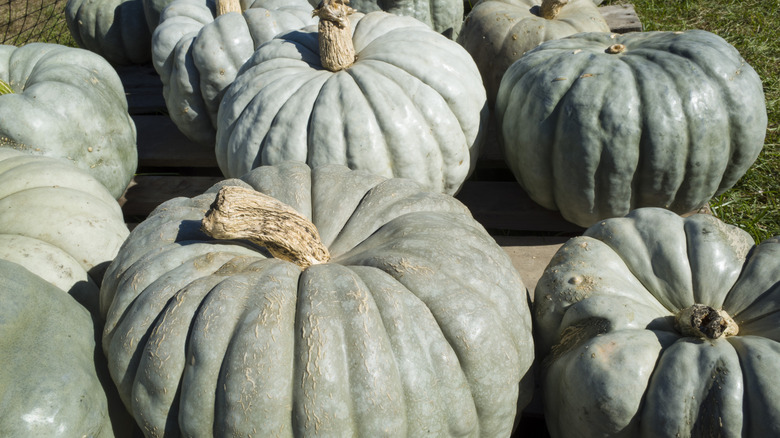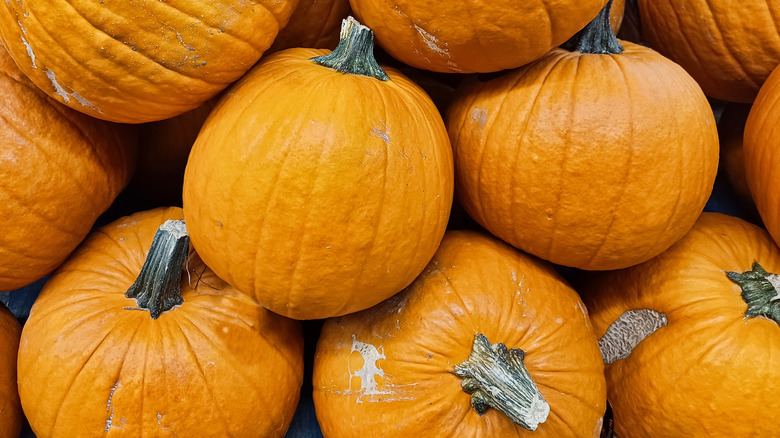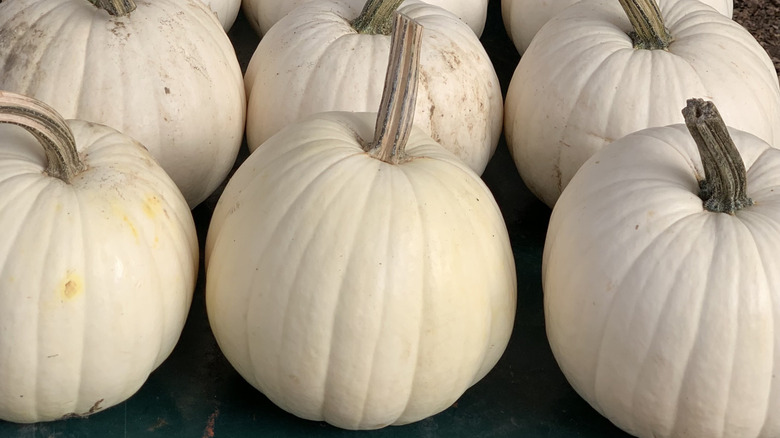The Best Pumpkin Varieties To Grow If You're A Fall Baker
Ahhhh, autumn! Sweater weather, leaf peeping, and all things pumpkin spice. If you're a baker and a gardener like me, you look forward to crafting baked things using food you've grown yourself, like apples, stone fruits, berries, and pumpkins. My pumpkin bread is a big seller at the small weekly farmers' market where I've been selling baked goods for over a decade. Many bakers use canned pumpkin, but you can't beat using a fresh pumpkin you've grown yourself. Here are some wonderful varieties perfect for baking: some popular, some lesser-known, but all are marvelously flavorful.
Pumpkin and winter squash belong to the same plant genus, Cucurbita maxima, and are basically interchangeable for culinary purposes. Canned pumpkin, which is pre-cooked and pureed, is often a variety of winter squash (Libby famously uses 'Dickinson' squash). The main difference between pumpkin and squash is the appearance and the texture of the skin. Both need to have the skin removed, before or after roasting or boiling, and then pureed before being used for baking.
While some pumpkins are desirable for decor because of size, shape, color, or skin texture, the thickness of the skin is a factor in preparation for baking. Generally, thin-skinned pumpkins (including "sugar" or "pie" pumpkins, and most "cheese" pumpkins) are easier to prepare and have delicious, smooth-textured flesh, whereas pumpkins carved for jack-o-lanterns often have stringy flesh. Growing pumpkins is fairly easy: They are planted from seed as annuals but will sometimes reseed. You need plenty of room and full sun for them to do well (go for smaller varieties if space is an issue).
Sugar pumpkins
The most popular pumpkin variety used for baking is the "sugar" pumpkin. There are specific cultivars with '"sugar" in the name (like the 'Small Sugar Pumpkin') and also a group of pumpkins known as "sugar" pumpkins which refer to smaller pumpkins with dense, sweet flesh. (The Sugar Pumpkins! What a good name for a band!) All sugar pumpkins are good choices for baking, and the seeds for these varieties are widely available and easy to grow. These compact pumpkins can be prepared one at a time for your cookery needs.
Rouge Vif d'Etampes (Cinderella)
A gorgeous French heirloom, the 'Rouge Vif d'Etampes' is more commonly known as the "Cinderella" pumpkin. Its deep vermilion color and wide, round shape, make it very decorative for fall displays. It also happens to be a great pumpkin for cooking and baking, with dense flesh that has a not-too-sweet flavor, so equally good for baking or savory dishes. The fruits of this large pumpkin can reach weights of up to 15 or 20 pounds, and growth takes 110 days from seed to maturity.
Musquee de Provence (Fairytale)
Another fabulous French heirloom, also with a more common name ("Fairytale"), the 'Musquee de Provence' is a large pumpkin (mature fruits can weigh up to 20 pounds) with a brownish orange color and beautiful oval shape with deeply grooved segments that make it easy to cut into. Like the "Cinderella" pumpkin, this one is commonly used for autumn displays, and since both have a long shelf life, after decorations are done, you can cook with them! This pumpkin has a fine-grained flesh that makes it wonderful for baking.
Long Island Cheese
My favorite baking pumpkin, bar none, is the cheese pumpkin! There are several cultivars available, and they're popular for decorative purposes. The 'Long island Cheese' pumpkin is a large, grooved pumpkin with dense, sweet, nutty flesh that's wonderful to bake with. I find cheese pumpkins are easy to prepare, too. No need to cut the skin off, just cut them up in chunks, roast them and gently "pinch" the skin off once the pieces have cooled. For my favorite varieties, I like to preserve pumpkin seeds for planting the following year, or to share with friends.
Seminole
'Seminole' pumpkins are small to medium-sized ones that are somewhat teardrop-shaped, with sweet flesh perfect for baking pies. They need plenty of room to grow, as the vines can get up to 100 feet long! The 'Seminole' pumpkin is suited to warm climates and can withstand hot, humid summers. This pumpkin is commonly grown in Florida, where it was cultivated in the Everglades by the Native American tribe it is named for, but the variety originates in Central America. It matures faster than some other pumpkin varieties, ripening in 90 days from planting.
Casper
Many folks love to decorate with pumpkins and feature different colors and sizes. White pumpkins are popular choices for this, but did you know there are also many white pumpkin varieties that are great for baking? The 'Casper' pumpkin (named after the friendly ghost, probably) is a medium-sized pumpkin that grows nine to 12 inches in diameter and averages between 10 to 16 pounds at maturity. Its dense flesh is sweet and tender, and is considered excellent for cooking and baking.
New England Cheddar
Another cheese pumpkin! Apparently named for its resemblance to wheels of cheese, as opposed to the cheese-like appearance of the flesh, this variety, the 'New England Cheddar,' is commonly grown in the Northeast and often sold at farm stands in the fall. It's medium sized, usually weighing between six to 16 pounds when mature. The thick orange flesh of the 'New England Cheddar' pumpkin has low moisture content and a velvety texture when cooked, and is delectably sweet, making it great for both roasting and baking.
Red Warty Thing
Yes, that is the actual name of this pumpkin and it's very apt. It's obvious why folks choose this one for decorating with, due to its vivid color and interesting texture, but the 'Red Warty Thing' is also a fine baking pumpkin. The skin is very thick on this pumpkin, so it does need a bit of effort to cut it and remove the skin, but the interior flesh is flavorful and dense, so it's worth the extra time. The 'Red Warty Thing' typically weighs between 15 to 20 pounds when ripe.
Speckled Hound
This colorful pumpkin is on the smaller side, with an average weight of three to six pounds. The 'Speckled Hound' is a two-toned beauty, a pale cantaloupe color with gray-green spots, making it a popular pumpkin for decor. But the 'Speckled Hound' pumpkin is also an excellent eating pumpkin. The thick flesh is deep orange in color and has low moisture content, which makes it great for many cooking uses, including baking.
Mellow Yellow
These pumpkins are commonly chosen for carving into jack-o-lanterns, given their large size (10 to 18 pounds), uniform round shape, and strong stems that can be used as a "handle". The bright yellow-orange color is also eye-catching. But the 'Mellow Yellow' pumpkin is terrific for baking, too. The flesh is a pale yellow color, is firm and crisp, and the taste has been described as earthy and sweet when cooked. This variety is also known to have good disease resistance, too, so be sure to save those seeds.
Baby Pam
The small but mighty 'Baby Pam' is a diminutive pumpkin (three to six pounds on average) that's the perfect size for baking pies. This round, bright orange pumpkin also has nice strong stems, so it's popular for decor. It is said to have similar flavor to the 'New England Pie' pumpkin. 'Baby Pam' has dry uniform flesh with a sugary taste, and is said to be a robust grower that's resistant to pests.
Jarrahdale
These uniquely-colored pumpkins have become stars of home decor magazines (one of Martha Stewart's favorite pumpkins) for their uniform gray-green color that looks classy and subtle in fall displays. The 'Jarrahdale' also has a decorative pale pink cousin ('Porcelain Doll'), that has a similar size and shape. 'Jarrahdale' is not just another pretty pumpkin, though: It's great for eating and has delicious sweet, firm flesh that is the pale orange color of ripe cantaloupe. It also has long storage qualities, making it perfect for decorating followed by cooking: A fitting fate for this gorgeous pumpkin.
Ghost Rider
The 'Ghost Rider' pumpkin may be named with Halloween decorating in mind, but it's also great for baking. It's large (15 to 22 pounds!) and nicely round, somewhat oval and upright, so it's great for carving. The deep orange color makes it nice for displays, and the interior flesh is also a lovely rich orange color. The flesh is thick, dense, and sweet, and a good choice for baking or savory dishes.
Snowball
This small white beauty (weighing between one and two pounds) is a cross between 'Casper' and 'Sugar Pie' pumpkins. The 'Snowball' is known to keep its white color through the season, making it a desirable decorative pumpkin. The 'Snowball' (also sometimes known as 'Snowball White Pie') is a nice round pumpkin with a long, sturdy stem that makes a great handle, so it's a popular choice for carving into a jack-o-lantern. The pale cream-colored flesh has a sweet, nutty flavor that is delicious in baked goods like pies, quick breads, and muffins.
